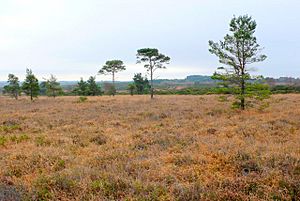Holt Heath, Dorset facts for kids
| Site of Special Scientific Interest | |
 |
|
| Area of Search | Dorset |
|---|---|
| Grid reference | SU030058, SU060040, SU096070 |
| Interest | Biological |
| Area | 766 ha, 1893 ac |
| Notification | 1977 |
Holt Heath is a special natural area in east Dorset, southern England. It covers about 4.88 square kilometers (1.89 square miles). This beautiful place is located near the village of Holt, about four miles northeast of Wimborne Minster.
The heath is a mix of different habitats. You can find dry and wet heathland, squishy bog areas, and old ancient woodland. It's a very important spot for nature. Because of its value, it has many special protections. These include being a National Nature Reserve, a Special Protection Area, a Special Area of Conservation, and a Site of Special Scientific Interest.
The National Trust owns Holt Heath. They work with Natural England to look after it. This ensures the heath stays healthy for all its plants and animals.
Contents
A Home for Unique Wildlife
Holt Heath is a fantastic place for many different creatures. It is one of the few spots in Britain where you can find all six native reptile species. Imagine seeing adders, grass snakes, common lizards, and slow-worms all in one place!
Rare Birds and More
Many other animals, plants, and birds also call Holt Heath home. It's especially important for rare heathland birds. Birds like the speedy hobby, the mysterious nightjar, the tiny Dartford warbler, and the singing woodlark all breed here. This means they build nests and raise their young on the heath.
The Importance of Grazing
For a long time, Holt Heath was used as "common land." This meant local people could let their livestock, like cows or sheep, graze there. This grazing was very important. It helped to keep the heathland open and healthy. The animals would eat the plants, stopping trees and bushes from growing too much.
Changes and Future Plans
However, in the middle of the 20th century, grazing stopped. Without animals eating the plants, the heathland started to change. It became less open, and some of the special habitats began to disappear. This was not good for the unique plants and animals that need open heathland to survive.
Now, there are plans to bring grazing back to Holt Heath. Workers are installing special cattle grids on the roads that cross the heath. These grids will stop the animals from wandering off the land. Once the grids are ready, livestock will return. This will help to restore the heathland to its natural, open state. It will make Holt Heath an even better home for its amazing wildlife.

